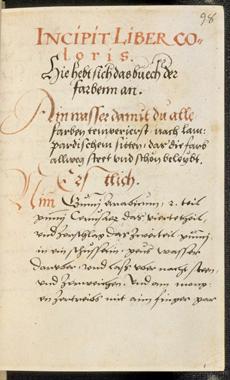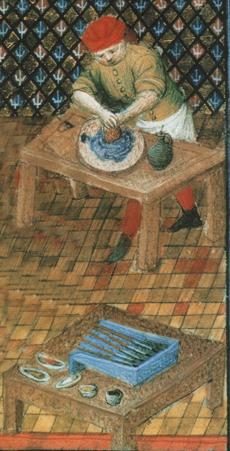During the 1550s, Wolfgang Seidel, a monk but also a copyist and illuminator at the Tegernsee monastery in Bavaria compiled two extensive collections of technical craft and medical recipes—currently preserved in the Bayerische Staatsbibliothek, Munich, as Cgm 4117 and Cgm 4118. The first volume is recorded under the title Kunstbuch oder von manigerlai Handwerchskünsten. It contains no less than 378 folios dedicated to various (art)-technological fields, such as metallurgy, painting, illuminating, and dyeing. It also includes alchemical instructions, remarks on some minerals, as well as information on other artisanal procedures using materials such as glass, crystal, ivory, gems, and gunpowder. The collection also gives instructions on the production of glaze for ceramics, among other substances.
Seidel’s collection was compiled over several years, during which time he collected different types of sources. The content of this recipe collection mainly comes from copies of older or contemporarily written documents. Some parts correspond to data gathered by Seidel from artists or practising scholars, as evidenced by the notes and titles that punctuate the text. For example, Seidel clearly states several times that he is indebted to the Bishop of Freising for recipes that he included in Cgm 4117 (on folios 1v, 2v, 35v and 37r). These prescriptions specifically describe how to melt gold, silver, and lead. Seidel also cites Bartholome Schobinger, a merchant from St. Gallen, famed for his deep interest in natural sciences and alchemy. The instructions recorded after Schobinger’s name delineate a number of alchemical methods that modify the properties of gold, or produce a golden colour, or give guidance on working with gold, silver, iron, and copper. Other instructions concern gilding or melting glass, melting horn or certain metals, preparing aqua fortis or manufacturing a blue pigment called “azure” (Cgm 4117, folios 62r–130r). Finally, it is worth noting that some instructions appear to be a personal contribution made by the scribe himself. Indeed, in the first folio of Cgm 4118, Seidel explains that while he has used both pre-existing written sources as well as information collected from his contemporaries, he has also drawn on his own practical experience too.

Fig. 2: Aberystwyth, National Library of Wales, Manuscript Brogyntyn ii.1, folio 33r.
The same complex modalities of composition are at the root of a considerable corpus of (artisanal) craft recipe collections. These writings were largely produced between the Middle Ages and the nineteenth century, if not later, and diffused among communities and society at large. A number of these texts are dedicated to specific subjects or techniques. For example, a manuscript currently kept in the Aberystwyth National Library of Wales deals with “the crafte of lymmynge of bokys” (fig. 1). For its part, the “Tractatus de azuro” (preserved in Cambridge, Gonville & Caius College) focuses more particularly on the manufacture and the preparation of natural or synthetic blue-producing pigments. In parallel, others, if not the greatest part of these texts, consist of unordered descriptions of miscellaneous art-technological instructions.
These recipe collections thus provide us with an immense amount of data related to various crafts and practices over a large chronological and geographical span. Many of them allow us to better understand how medieval and early modern artisans produced and prepared their pigments, colourants, glues, media, inks, and so on (fig. 3). In parallel to the physical descriptions of artistic materials, the recipes provide information concerning optical characteristics, or means of conservation, the (in)compatibility between the various substances used, and information regarding different materials’ ageing properties.
Nevertheless, to date, only a few examples of these collections of recipes have been exploited in technical art history’s scope of study. This is not least because most of them correspond to handwritten texts transmitted through centuries by the process of copying down their contents. The use of abbreviations, the complexity of the handwriting, the change in meaning of (technical) terms, but also sometimes the translation from one dialect or language to another—all of which go hand in hand with this process of diffusion—necessitate the recourse to various skills essential to undertake an in-depth study of this particular type of source material.

Fig. 3: Paris, Bibliothèque nationale de France, Manuscrit Français 12420, Giovanni Boccaccio, De Claris mulieribus, folio 86r, Thamar painting the Virgin, (detail of the apprentice).
The Colour ConText database has been developed to facilitate the consultation and exploitation of this large corpus of recipe collections, making sources available via transcriptions, translations, and digital images. Thanks to subject classification, keywords can be used when researching specific recipes, methods, or materials. The database’s different thesauri allow users to combine an ingredient with a specific technique, mentioned in a limited geographical/chronological framework, when making their search.
For example, the combined search for “Alum” and the colour “red” shows that 350 entries are concerned with this substance and the production of red. This result can be further filtered by glossary, artistic technique, or content type. The Colour ConText database can also help to identify specific, datable practices and materials. For example, we have observed that a significant number of procedures involving anthocyanin colourants (obtained from the juice of flowers and berries, such as poppies, cornflowers, or blueberries) are specifically described within a group of texts written in the south of Germany between 1400 and 1560.
The database also contains lists of objects and materials indexed both by their current scientific name (“Current names”) and by the “historical” terms precisely as they appear in the source texts (“Historical names”). These glossaries have been built as relational tables that allow the retrieval of all the different historical names used for one particular material—detailing the historical written context—as well as enabling the user to see the various materials that may relate to a specific name. For example, the puzzling denomination “red of Paris” relates to several sorts of substance. In the Illuminier Buch by Valentin Boltz von Ruffach, it is used to designate a red pigment obtained from brazil wood. However, other sources make a distinction between Paris red and the red pigment obtained from brazil wood by recommending the use of either the former substance or the latter (“Ein guot röselin oder pfirsÿg bluot Nu nim presilgen oder paris rot,” Colmarer Kunstbuch, recipe 35). In the Codex Palatinus Germanicus 489 from Heidelberg (fig. 2) a recipe describes a “Paris rot” made from brazil wood and an unspecified lake. Within this same manuscript, another recipe details the preparation of “Rotenn Paris” from a lake. It has therefore been hypothesized that this appellation was used as a way to distinguish a specific hue.
Colour ConText also gives access to the metadata of the sources, with details such as title, language, location, the provenance, and the circulation of these manuscripts and books (place and date of origin or publication), scribes or authors and previous owners. This particularly useful function allows users to pursue questions on the circulation of these recipes outside the workshop. Finally, the database includes a description of other types of recipes, related to various fields such as botany, pharmacology, or medicine. This information would serve to better estimate the relationship and connections between artists’ knowledge and other types of knowledge, between the worlds of making and materials and the worlds of scholarship and texts.
